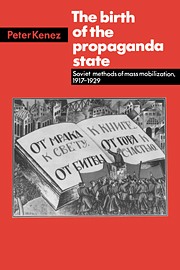Book contents
- Frontmatter
- Contents
- List of illustrations
- Preface
- Introduction: The Soviet concept of propaganda
- Part I The Civil War
- 1 The press
- 2 The struggle for the peasants
- 3 Liquidating illiteracy in revolutionary Russia
- 4 The Komsomol in the Civil War
- 5 The political use of books, films, and posters
- Part II The new economic policies
- Conclusion and epilogue
- Notes
- Glossary
- Bibliography
- Index
4 - The Komsomol in the Civil War
Published online by Cambridge University Press: 02 December 2009
- Frontmatter
- Contents
- List of illustrations
- Preface
- Introduction: The Soviet concept of propaganda
- Part I The Civil War
- 1 The press
- 2 The struggle for the peasants
- 3 Liquidating illiteracy in revolutionary Russia
- 4 The Komsomol in the Civil War
- 5 The political use of books, films, and posters
- Part II The new economic policies
- Conclusion and epilogue
- Notes
- Glossary
- Bibliography
- Index
Summary
Soviet publicists have usually depicted their society in terms of mechanistic images. The Party is the “engine” of society, which provides the force necessary for change and development. Ideas generated by the Party come to the “masses” by “transmission belts.” These transmission belts are the mass organizations, such as the trade unions, the Zhenotdel, and the Komsomol.
As with so many other aspects of political life, in exploiting these organizations for the purposes of mass mobilization the Soviet regime was advancing on uncharted territory. Sometimes consciously and sometimes unconsciously the Bolshevik leadership found solutions that then became permanent features not only of the Soviet state but also of many modern states, not all of them communist.
The mass organizations were genuinely important: They popularized ideas developed elsewhere, and they carried out policies introduced by the Soviet leadership. They enabled the regime to tailor its propaganda for certain segments of the population, and they extended the reach of the Party. They were involved in all propaganda campaigns initiated by the Party, whether the goals were long term and far reaching, such as educating the future communist man and woman, or short-term and immediate, such as collecting scrap metal or bringing in the harvest in record time. The Soviet political landscape has been dominated by these campaigns ever since the Bolshevik Revolution.
The mass organizations served another propaganda purpose, perhaps less evident but nonetheless even more important than organizing campaigns. They provided a sphere of activity for tens of thousands of enthusiasts.
- Type
- Chapter
- Information
- The Birth of the Propaganda StateSoviet Methods of Mass Mobilization, 1917-1929, pp. 84 - 94Publisher: Cambridge University PressPrint publication year: 1985



